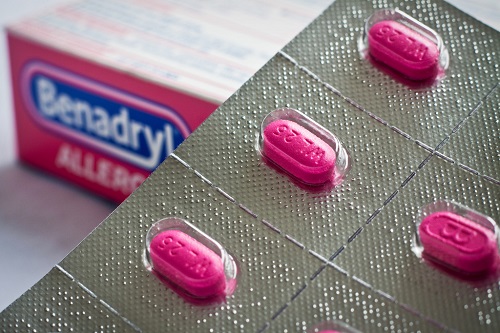Benadryl is one of the most common medications used to treat allergies. There are multiple forms of this drug that can be used to treat allergies within the body or on the skin. This drug is readily available over the counter, but you may be able to get a stronger version with a prescription that can be used to treat extreme allergic reactions. There are not many severe side effects associated with Benadryl if it is taken properly. Work with your doctor or pharmacist to learn about the best way to start a Benadryl regimen to help avoid your nasal and allergy symptoms.
How to Use Benadryl Properly
Functions: Benadryl is the brand name for the drug diphenhydramine. It can be administered to treat cold and flu symptoms such as stuffiness, sneezing, headaches, respiratory distress or nasal discomfort. Topical forms can be used to treat itching, scaling, hives or other discomforts.
Forms: Benadryl is available in liquid form, a chewable capsule, quick release tables, traditional capsules, and a topical cream. In extreme cases you can apply an injection of Benadryl directly to a muscle. Each of these is available in different concentrations. Therefore, they can be applied to different age groups and people of different sizes. So, there is no need to take large amounts of pills at once.
Note: Benadryl will be taken throughout the day as needed. You will need to read the instructions for your particular form to make sure you are aware of how long you should wait between doses and learn how many you are supposed to take during the day. In most cases, Benadryl does not need to be taken with food, but you can choose to take it with a meal to avoid upsetting your stomach. You may also like to drink a glass of water to help you swallow the medication.
How Much Benadryl Should You Take?
There are many manufacturers that provide Benadryl, so dosing and capsule sizes may be different for your prescriptions. Read all of the instructions before you take your medicine so that you are aware of how it should be used.
- Adults and those over 12 years of age can take anywhere from 25 to 50mg every 4-6 hours. The size of Benadryl doses is directly determined by the size and weight of the patient. Those over 100 pounds (about 45kg) can take a full dose of Benadryl. Children under 25 pounds (around 11.5kg) should not use Benadryl. The average dose for children is between 12.5-25mg every 4-6 hours which can be increased as they grow.
- The minimum effective dose of Benadryl is 12.5mg or ml in one day depending on whether you are taking a capsule or liquid form. The maximum intake is 50mg for a full sized adult. Children should not take more than 25mg.
- The topical version of Benadryl can be applied as needed throughout the day. Some versions are limited to 4 applications throughout the day, depending on the strength of the medication. Your doctor will probably prescribe a dosing schedule if you are using this medication to treat a specific outbreak. Topical Benadryl is not intended to be used over large portions of your skin, so ask your doctor or pharmacist where and how much you can apply this mediation without overdosing.
Know the Side Effects of Benadryl
- The most common side effects: drowsiness, heartburn, and dryness of the nose, mouth and throat. In most cases these side effects are not severe and become less severe as the patient begins to use the drug more regularly. Heartburn can often be avoided if patients pair their dosage with food. Because drowsiness is so common when taking Benadryl, you should not plan on driving, operating machinery or performing any tasks that require your full attention until the effects of the drug have passed. If you find the side effects of Benadryl are severe enough to interrupt your daily function, talk with your doctor about recommendations on how to adjust your dosage to avoid these issues.

- Less common side effects: nausea, vomiting, or loss of appetite. Most patients who suffered from these side effects said they were minor and did not interrupt their daily life. You can often avoid these reactions if you take your dose with food or take a smaller dose than you were originally consuming.
- Side effects that need doctor's attention: constipation, irritability, shakiness, nervousness, difficulty breathing or rash while on Benadryl. If these side effects become severe you should contact your pharmacist for advice. If you cannot breathe or you feel as though you might lose consciousness, contact emergency medical assistance right away.
- Benadryl and Allergy: If you are dealing with a rash, hives, itching or swelling that is severe in addition to any of these other symptoms, you may be suffering from an allergic reaction to the medication. Stop taking Benadryl right away and contact poison control or your doctor to find out what to do next. Your Benadryl container may have a contact number that you can use to get information on potential allergy risks and what to do about them.
Pay Special Attention If You Are...
- Children are more likely to develop side effects to Benadryl if they are taking a dose that is too strong for them. Read the instructions on dosing for their size so you can ensure that they are taking the proper amount of Benadryl.
- Seniors may also have more of a tendency to develop side effects if they take Benadryl on a regular basis, so talk with your doctor about how often it is safe to take this medicine.
- Pregnant women are welcomed to use Benadryl, though they may need to talk with their doctor about how this drug will interact with any medications they may be taking.
- Those with liver disease may have trouble clearing Benadryl from their system. You should talk with your doctor about the safe doses to avoid side effects or overdosing. Get professional advice from your doctor whenever necessary.
- Those who have heart disease or ulcers may see a worsening of their condition if they take heavy doses of Benadryl on a regular basis. Talk with your doctor about what size dose is appropriate if this is your case.
Benadryl Interactions You Must Know
- Benadryl should not be paired with alcohol. This will significantly increase your chances of developing a negative reaction to the medications.
- Items such as tranquilizers or medications like sleep aids or anxiety meds can increase the drowsiness commonly associated with Benadryl. Tranquilizers can also increase the likelihood of developing nausea while taking the drug.
- You should not take other allergy medications while you are on Benadryl to avoid an overdose.
- Benadryl is not intended to be taken regularly for long periods of time. If you have allergies that need to be addressed with a regular drug regimen, talk with your doctor to determine how safe it is to use Benadryl for this task.
